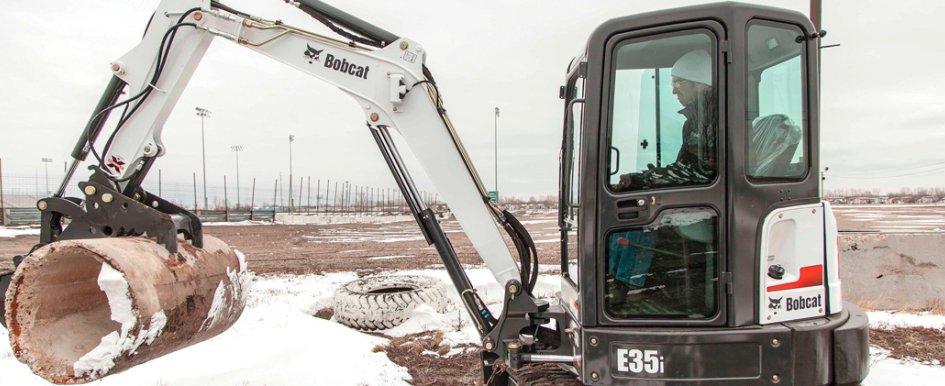
The decision to store your compact excavator during winter can be based on a variety of factors, including where your business is located geographically and what type of work you do on a daily basis. If your company is located in the southern portion of the United States and in need of a compact excavator year round, chances are you will not be storing your equipment. On the other hand, if your business is located in the northern region and your excavator is not used until after the ground thaws, you should strongly consider storing your excavator and attachments.
Your excavator requires preparation and maintenance before and after storage to ensure reliable operation once it is returned to service. Tips you should consider before storing your excavator include keeping the machine out of the winter elements, checking fluids, oils and filters, inspecting the tracks and examining hydraulic hoses and attachment connection systems.
Tip 1: Prep the excavator for storage
Other preparation tasks owners should complete before winter storage include:
- Thoroughly clean the machine of grease and debris, including the engine compartment.
- Lubricate the excavator as noted on the machine's service schedule.
- Lightly grease any exposed cylinder rods as stated in the manufacturer's operation and maintenance manual.
- Tag the machine to indicate it is in storage condition.
As a final step before storing an excavator for an extended period of time, make sure to lower the boom fully with the bucket flat on the ground and place all controls in the neutral position. The blade should also be fully lowered to the ground's surface.
Tip 2: Complete a visual inspection
After prepping the excavator, you should complete a walk-around and note any obvious maintenance items you see. If there are worn or damaged parts, make sure to replace them. At a minimum, document items that will need attention prior to returning the machine in the spring season. This will help reduce downtime once you decide to return your excavator to service. You should also look for signs of damage or cuts to the rubber tracks. Steel tracks should be inspected for excessive wear. Ideally, tracks should be inspected in late fall or early winter before storage. Other items to look for include the following:
- Inspect cutting edges and teeth on excavator bucket for wear or damage.
- Check hoses for nicks, cuts and patches; replace if needed.
- Identify if workgroup bushings need to be repaired.
- Check the condition of the seals and bushings on the pivot points.
- Check engine accessory belt(s) for wear.
Tip 3: Check fluids, oils and filters
Make sure to not overlook engine oils, coolant, fuel and hydraulic levels before storing your excavator. If you are getting close to your next preventive maintenance schedule, it is a good idea to replace hydraulic fluids and fuel and air filters at this time.

Refer to your manufacturer's operation and maintenance manual to determine what the proper fluid levels are for your excavator.
Before storage, place a fuel stabilizer in the fuel tank and run the engine for a few minutes to circulate the stabilizer to the pump and fuel injectors. If there is a possibility that the machine will be taken out of storage during winter, then make sure to add the appropriate anti-gel additive to the fuel. Even if you are not using your machine until after winter, it is important that fuel and fuel systems are in proper working order while in storage.\
Tip 4: Disconnect the battery
Disconnecting the excavator's battery and storing it in a cool, dry place above 32 degrees Fahrenheit helps eliminate the potential for battery discharge in cold weather. Be sure the battery has the correct electrolyte level. Charge the battery periodically while it is in storage.
Tip 5: Keep it covered
Harsh temperatures during the winter months can harm excavators externally as well. Keeping your machine in a dry, protected shelter can help prevent paint chipping, cracked seats and degradation of wires and hoses. Make sure to cover the excavator, especially the exhaust pipe opening, to prevent snow and cold air that could potentially impact internal components. An excavator stored inside and out of the elements tends to have a higher retail value than an excavator stored outside and fully exposed to the winter elements.
Tip 6: Don't forget about attachments
Hydraulically driven attachments, such as breakers, planers, augers and plate compactors, should be stored inside and out of the elements. Inspect hoses fittings and hardware for integrity and note items that will need attention prior to the upcoming season.
Returning the machine to service
Before you return the excavator to service, remember to check the external and internal components of the machine. Complete the following items before using your excavator:
- Install a fully charged battery.
- Check the engine, hydraulic oil levels and coolant levels.
- Remove grease from the exposed cylinder rods.
- Inspect all belt tensions.
- Make sure shields and guards are in place.
- Lubricate the excavator as needed per the machine's service schedule.
- Remove the cover from the exhaust pipe opening.
- Start the engine and let it run for a few minutes, observing the instrument panels and systems.
- Turn off the engine and check for leaks.
Keeping your excavator out of the winter elements, checking fluids, oils and filters, inspecting the tracks and examining hydraulic hoses and attachment connection systems can help reduce costly machine downtime, allowing you to quickly return your machine to service.
For more in-depth instructions on how to store your excavator, refer to the preventive maintenance section available in your manufacturer's operation and maintenance manual.
